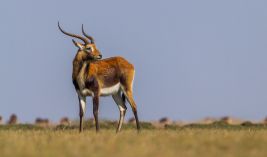Kilombero North Safaris Ltd - Kilombero Valley
The beautiful terrain in Kilombero Valley has been one of the big game hunters favorite areas for generations. The areas along the Kilombero Valley provide the setting for some of the best hunting to be found in Africa. This contrasting landscape provides ideal conditions for a variety of interesting game species. Tanzania and not least Kilombero in particular is famous for exceptional buffalo hunting.
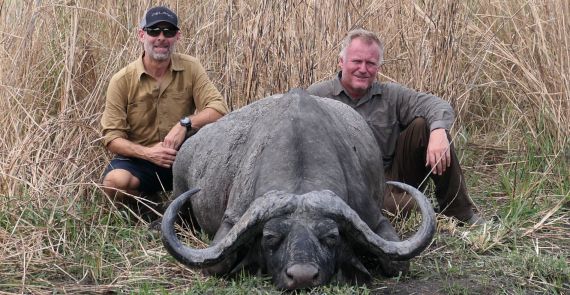
Highlights
- Hunting in a beautiful and varied landscape
- Unique opportunity to take several different exciting species
- Excellent hunting for first class trophies
- Unique buffalo hunting that can challenge any hunter
- High quality hunting camps
7 days from $19,995
The Kilombero Valley consist of over 14,000 square kilometers of unspoiled African wilderness. Here you will find a minimal human footprint. Kilombero contains one of Africa's most scenic ecosystems with large rivers, forests, miombo forests and mountains.
Kilombero Valley's unique terrain, density of buffalo and excellent trophy quality contribute to some of the best buffalo hunts in Africa. In our Kilombero hunting blocks you will find fantastic buffalo habitats with grass covered miombo forests and many kilometers of rivers flowing through the area.
The large population of buffalo also attracts large numbers of lions and leopards, making the Kilombero Valley a particularly good hunting ground for the big cats.
Most of the river systems in the Kilombero Valley are untouched by humans. These unspoilt rivers are thus automatically home to large numbers of hippos and ancient crocodiles. Compared to other rivers that run through our hunting blocks in the Kilombero Valley, our hunting quota for crocodiles and hippos is low, resulting in excellent trophy quality animals.
The river systems of the Kilombero Valley also offer ideal fly fishing conditions for large tigerfish. In certain areas you can fish from the river bank or from a boat. We have experienced fishing guides who are happy to share their knowledge.
Kilombero Valley is therefore the area you should hunt in if you want hunting experiences of completely unique quality!
Hunting season
The hunting season in Tanzania is from 1 January to 31 December.
Video Gallery
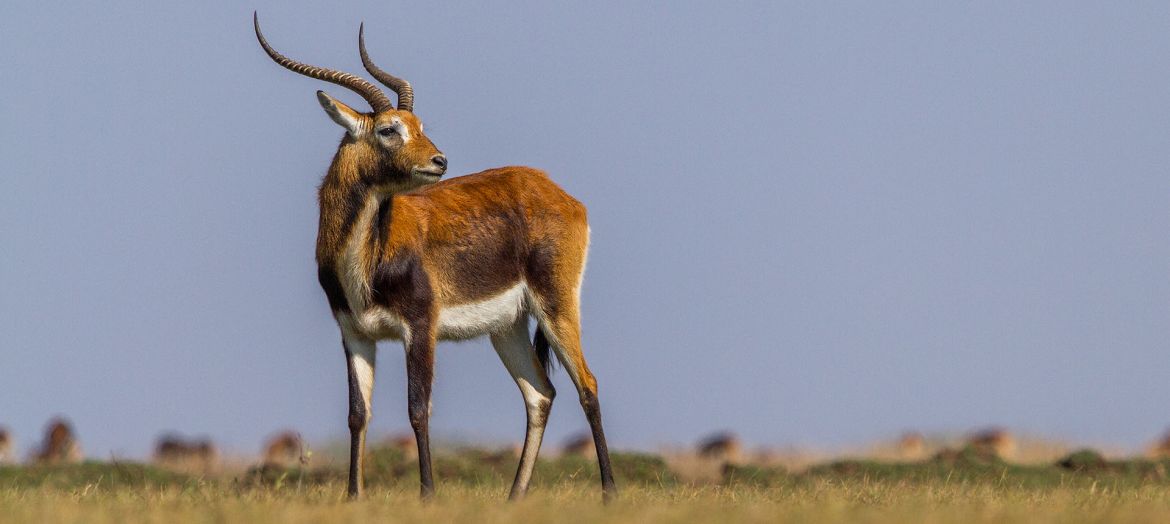
-
 Hunting in Africa
Hunting in Africa
Accommodation
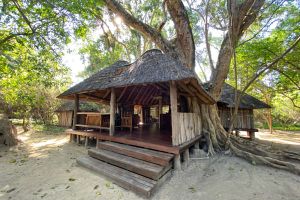
Camps in the Kilombero Valley
We have three different camps in Kilombero Valley, all of which are built in typical East African style and are very comfortable with nice tents/bungalows, with good beds, clothes racks, shelves and chairs. Ruhudji CampThis exclusive camp is located on the banks of the Ruhudji River and offers a true East African experience. Three spacious tents, beautiful living/dining area, 220 volt...
Read moreHunting Area
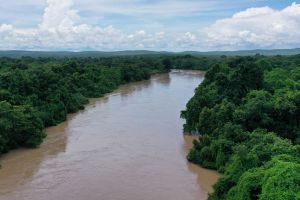
Kilombero Valley
The Kilombero Valley consists of over 14,000 square kilometers of African wilderness. Here you will find a minimal human footprint. The area contains one of Africa's most scenic ecosystems with large perennial rivers, forests, miombo forests and mountains. Here you will find, among other things, the greatest density of buffalo in all of Tanzania. The native buffalo herds attract large...
Read morePartner
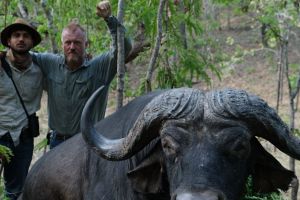
Partner in Tanzania
Kilombero North Safaris is managed on a daily basis by Quintin Whitehead and Zidane Janbeck, who offers unique hunting experiences for the discerning hunter in Tanzania. Quintin and Zidane together have over 25 years of hunting experience in Tanzania and have large hunting areas in the Kilombero Valley, good hunting blocks in Masailand and not least in the Ruaha Ecosystem. Quality and unique...
Read moreGame
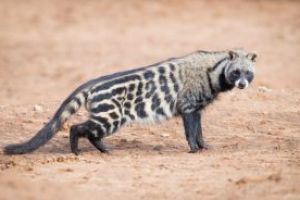
African Civet
Scientific Name: Virerra civetta Subspecies: There exist several subspecies of Viverra civetta, but they are not described here as they have little or no significance as hunting trophies. Distribution: Most African countries south of the Sahara Desert. Habitat: All types of savanna, sometimes dense forest. Description: Dog size animal, looking like a mixture between a stoat and a badger....
Read more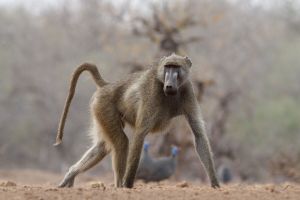
Baboon
Scientific Name: Papio sp. Sub-species: Five species are currently recognised (this is some disagreement on whether they are true separate species or sub-species. The true number of sub-species is also currently unknown) Hamadryas baboon (P. hamadryas) - Horn of AfricaGuinea baboon (P. papio) - Far western AfricaOlive baboon (P. anubis)- north central african savannahYellow baboon (P....
Read more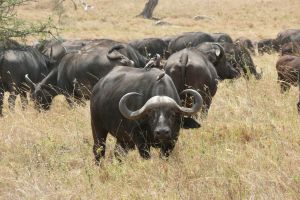
Buffalo, Cape
Videnskabeligt navn: Syncerus caffer Underarter: Dværgbøffel (Cyncerus c. nanus), Savannebøffel (Cyncerus c. S. c. brachyceros ), Nilbøffel (Syncerus caffer aequinoctialis). Cafferbøffel (Cyncerus caffer caffer Udbredelse: Nilbøflen er den af de fire arter der har det nordligste udbredelsesområde: Fra Senegal i vest i et bredt...
Read more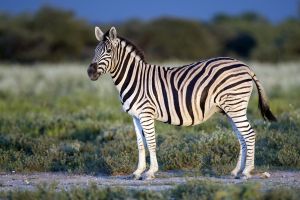
Burchell's Zebra
Videnskabeligt navn: Equus burchelli Underarter: Grant's Zebra (E.b. böhmi) Chapman's Zebra (E.b.antiquorum) Udbredelse: Burchell's Zebra: Botswana og Sydafrika. (den ægte burchell's zebra er uddød). Grant's Zebra: Mozambique, Tanzania, Kenya, Uganda og Ethiopien. Chapman's Zebra: Sydafrika, Mozambique, Zimbabwe, Botswana, Namibia, Angola, Zambia. Levested: Åben bush og...
Read more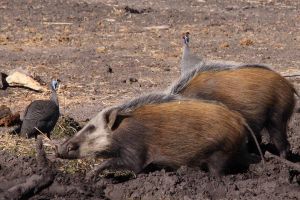
Bush Pig
Scientific Name: Potamochoerus porcus Subspecies: Up to 18 recognised species, here described as one. Distribution: All of Africa south of the Sahara Desert, excepting the desert of Namibia. Habitat: High forest, their fringes and thick bush country, often near rivers. Frequents fields where they cause much damage. Description: A domestic pig-like animal, weighing around 100 kg and measuring...
Read more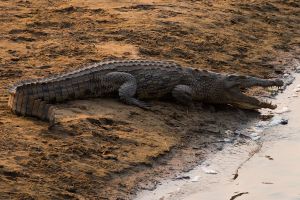
Crocodile, Nile
Scientific Name: Crocodylus niloticus Subspecies: No subspecies are currently formally recognised, however up to seven have been proposed. Distribution: The most common African crocodile, present over much of the sub-Saharan Africa from Lake Nasser in Egypt and the River Nile Sudan to the north to the Okavango Delta of Botswana and the Olifants River of South Africa in the...
Read more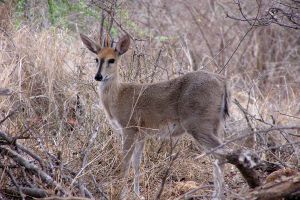
Duiker, Grey/Duiker, Grimm's (Common)
Scientific Name: Sylvicapra Grimmia Subspecies: Classification of subspecies is very variable, we have chosen only to count two: Western Bush Duiker and East African Bush Duiker. Distribution: From the desert rim in Northern Africa to the Southern tip of the Continent, the West African rainforest excepted. Habitat: As the species is a typical bush duiker it lives, as the name suggests in...
Read more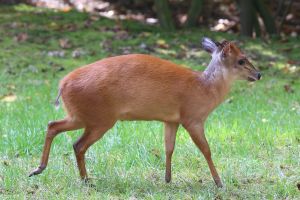
Duiker, Red
Videnskabeligt navn: Cephalophus natalensis Underarter: Ingen. Udbredelse: Udbredelsesområdet for denne art følger et bredt bælte langs den afrikanske østkyst fra Somalia i nord til Natal i Sydafrika i syd. Levested: Foretrækker tætte skovbevoksninger men findes også i visse områder i bush. Beskrivelse: Lille rødbrun antilope med en...
Read more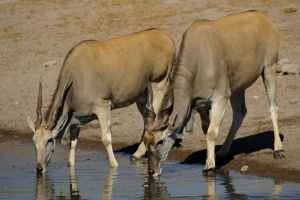
Eland, Cape/Livingstone, Patterson's
Scientific Name: Taurotragus oryx livingstoneiSubspecies: SCI lists Cape Eland as Tragelaphus oryx with three subspecies, which means that SCI counts the Cape Eland with the spiral horned antelopes. We have chosen to list Cape Eland under it's scientific name Taurotragus with two subspecies: Livingstone's Eland (Taurotragus oryz livingstonei) East African Eland (Taurotragus o....
Read more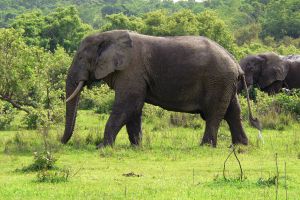
Elephant (Africa)
Videnskabeligt navn: Loxodonta afrikana Underarter: Forest Elephant (Loxodonta a. cyklotis) Pygmy Elephant (Loxodonta a. pumilio) Udbredelse: De tre arters samlede udbredelsesområde: Hele Afrika syd for Sahara. Dog bør det nævnes at i Vestafrika lever elefanterne i dag i små isolerede bestande, og først fra Cameroun og østover kan man tale om...
Read more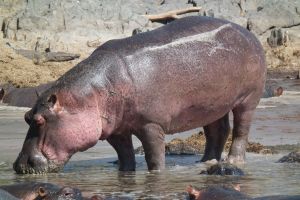
Hippopotamus
Videnskabeligt navn: Hippopotamus amphibius Underarter: Ingen. Udbredelse: I stort set samtlige lande syd for Sahara. Levested: Langs floder og i søer. Beskrivelse: Flodhesten er næst efter elefanten det største landlevende pattedyr. Flodhesten har en kompakt krop og korte kraftige ben. Den opnår en vægt på op til 3,5 tons og en højde på 1,5...
Read more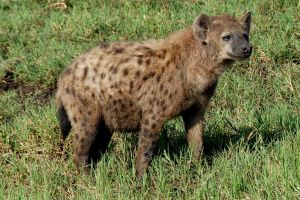
Hyena, Spotted
Videnskabeligt navn: Crocuta crocuta Underarter: Ingen. Udbredelse: Det meste af Afrika med udtagelse af den vestafrikanske regnskov og Sydafrika. Levested: Åben bush og græssletter. Beskrivelse: Mellemstort hundelignende dyr med kompakt krop og kraftige ben. Den opnår en vægt på ca. 70 kg og en højde på 80 cm målt over skuldrene. Hovedet er...
Read more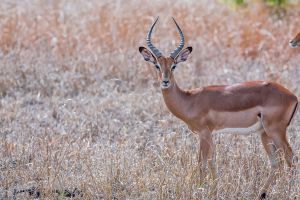
Impala
Scientific Name: Aepyceros melampus Subspecies: East African Impala (Aepyceros m. rendillis) Angola Impala (Aepyceros m. petersi) Distribution: South Africa, Mozambique, Zimbabwe, Botswana, Namibia, Angola, Zambia, Tanzania, Kenya, Uganda and Congo (Zaire) Habitat: Open bush and Acacia savanna Description: The three species are here descriped as on as the difference in appearance is negligent...
Read more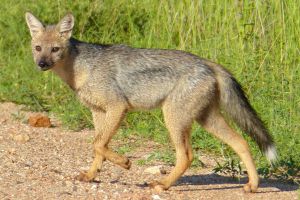
Jackal, Side-stribed
Videnskabeligt navn: Canis adustus Underarter: Ingen. Udbredelse: Fra Centralafrika og sydpå til det nordlige Namibia og Botswana samt det sydlige Mozambique. Levested: Åben bush og græssletter. Beskrivelse: Mindre rævelignende dyr der vejer ca. 10 kg og måler 45 cm overskuldrene. Pelsfarven er gråbrun med lyst bryst og hvid halespids. Langs siden har den...
Read more
Klipspringer
Videnskabeligt navn: Oreotragus oreotragus Underarter: Ingen. Udbredelse: Sydafrika, Namibia, Botswana, Zimbabwe, Mozambique, Angola, Zambia, Tanzania, Kenya, Congo, Etiopien Sudan. Levested: Små isolerede klippeformationer samt bjerge. Beskrivelse: Lille antilope med en vægt på 10 - 15 kg og en skulderhøjde, der normalt ikke overstiger 60 cm. Klipspringeren er...
Read more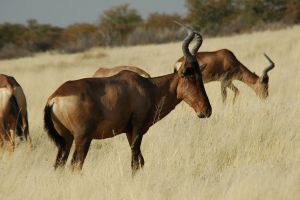
Kongoni/Coke's Hartebeest
Scientific Name: Alcelaphus b cokeii Subspecies: Is itself a subspecies of Alcelaphus Buselaphus. Distribution: Kenya, Tanzania and Ethiopia. Habitat: Open bush and savanna Description: Middlesized antelope that weighs around 170 kg and measures 120 - 140 cm over the shoulder. General colour light brown. The horns are heavy and deeply ridged, lyreshaped at first then curved sharply backwards...
Read more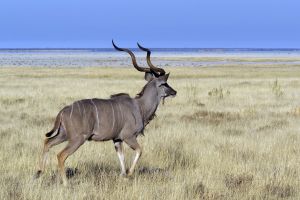
Kudu, Greater
Scientific Name: Tragelaphus strepsiceros Subspecies: Southern Greater Kudu (Tragelaphus strepsiceros strepsiceros) East African Greater Kudu (Tragelaphus str. bea). Western Greater Kudu (Tragelaphus str. cottoni) Distribution: From Chad, Sudan and Ethiopia in the North through all countries along the East coast as well as Zimbabwe, Zambia, Namibia, Botswana, Angola and South Africa. Habitat:...
Read more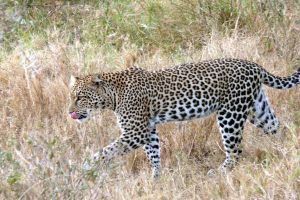
Leopard (Africa)
Videnskabeligt navn: Panthera pardus Underarter: Ingen Udbredelse: Hele Afrika syd for Sahara. Levested: Alle typer af terræn (selv udkanten af boligområder). Beskrivelse: Mellemstort dyr af kattefamilien med kompakt krop og kraftige ben. Leoparden kan opnå en vægt på 60 - 90 kg og en højde på ca. 70 cm. Skindet er gyldent med sorte ringe. Leoparden...
Read more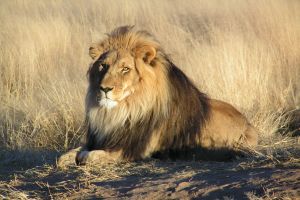
Lion (Africa)
Videnskabeligt navn: Panthera leo Underarter: Der anerkendes op til 7 geografiske underarter af løve. De beskrives her alle under et. Udbredelse: De forskellige løveunderarter har et fælles udbredelsesområde, der strækker sig fra Senegal i vest til Ethiopien og Somalia i øst samt i et bredt bælte langs Afrikas østkyst til det nordlige...
Read more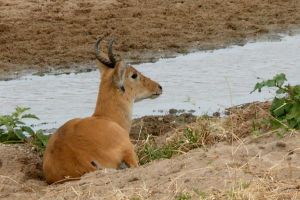
Reedbuck, Bohor/Reedbuck, Bohor
Wissenschaftlicher Name: Redunca redunca Subspecies: Western Bohor Reedbuck (Redunca r. nigeriensis) Eastern Bohor Reedbuck (Redunca r. Wardi) Distribution: Western Bohor Reedbuck: Nigeria, Cameroun,Chad, CAR, Burkina Faso and Benin. Eastern Bohor Reedbuck: Kenya, Tanzania, Uganda and Congo (Zaire) Habitat: Open bush and grassland Description: Middlesized antelope with a shoulderheight of up...
Read more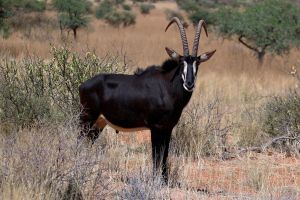
Sable Antelope (Africa)
Videnskabeligt navn: Hippotragus niger Underarter: Hippotragus n. kirkii, Hippotragus n. roosevelti. Giant Sable (Hippotragus n. Variani) beskrives ikke da den på nuværende tidspunkt er truet af udryddelse. Udbredelse: Sydafrika, Mozambique, Zimbabwe, Zambia Botswana, Namibia, Tanzania og Kenya. Levested: Åben bush og græssletter men findes også ofte i miombo- og...
Read more
Warthog
Videnskabeligt navn: Phacochoerus aethiopicus Underarter: Der anerkendes op til 7 underarter, der her beskrives under et. Udbredelse: Hele Afrika syd for Sahara med undtagelse af den vestafrikanske regnskov samt ørken områder i Namibia. Levested: Åben bush og græssletter. Beskrivelse: Mindre griselignende dyr der opnår en vægt på 100 kg og en...
Read morePrices

The price includes
- Hunting/hunting with experienced professional hunt guide, as well as all camp staff, such as tracker, cook, skinners, waiters etc.
- Government fees consisting of hunting license, concession fee, dipping and packing, gun license for a weapon as well as value added tax (VAT), community development grants
- All transport during the hunt in 4-wheel-drive vehicles
- Stay in a comfortable safari camp as described with full board including alcoholic beverages
- Skinning, dipping and trophy preperation
- Assistance when entering and leaving Tanzania
The price does not include
- Flight to Dar es Salaam round trip
- Air charter or road transfer to the camp
- Trophy fees
- Weapon import permit US$ 300 for additional weapons
- Hotel accommodation and expenses before, during and after the safari days.
- Tips
- Visa to Tanzania around US$ 50 upon entry or online before hunt
- Cancellation and travel insurance
- EU- Public liability insurance US$ 12,00,- per person
Price per non-hunter
USD 450$ per day
See the current trophy pricelist HERE
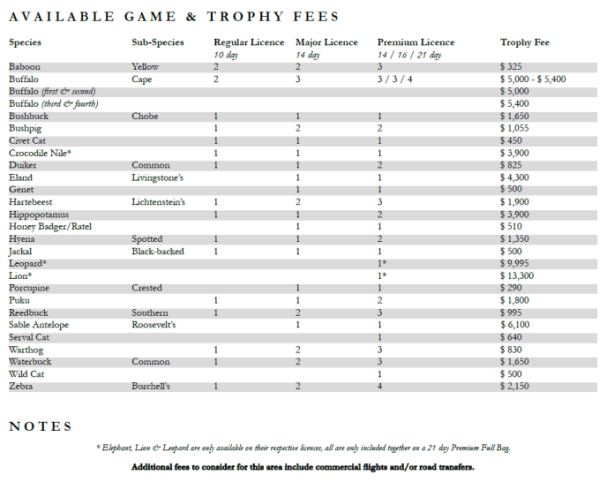
Pris pr. ledsager
USD 450$ pr. dag













